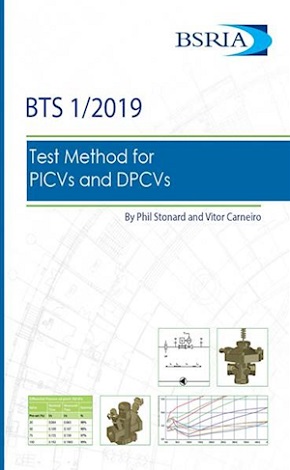BSRIA launches updated Valve Test Standard

|
In November 2019, BSRIA launched an updated version of BSRIA Technical Standard BTS/1 2019 – Test Method for PICVs and DPCVs. The new standard supersedes the original version launched in 2012 and now includes a new, dedicated method for testing differential pressure control valves.
The changes made to the PICV testing method within the standard include:
- An updated schematic of the test-rig setup.
- Introduction of clearly-defined test tolerances for all measured parameters.
- Implementation of a prescribed stabilisation period prior to each of the performance tests being carried out and a reduction in the number of cycles per test.
The method for performance testing DPCVs is divided into the following two stages:
- Fixed Load Tests – this test indicates any inherent hysteresis in the valve differential pressure performance as differential pressure outside the controlled loop rises and falls across the full range of the DPCV.
- Variable Load Tests – this test indicates any inherent hysteresis in the valve differential pressure performance as flow rate rises and falls across the full range of the DPCV.
The standard is free to download from the BSRIA website.File:Dd7ANn W300
[edit] Vitor Carneiro, Senior Test Engineer, BSRIA Test, said:
“We are delighted to announce the launch of the latest version of BTS1/2019, which is the amalgamation of seven years' testing experience and engagement with key industry stakeholders to deliver a streamlined and more clearly defined set of requirements. We look forward to further supporting industry and working with new and existing clients to deliver robust results to demonstrate product performance”.
BSRIA provides expertise and testing services to measure parameters such as flow-rate coefficient, pressure drop and control characteristics on a wide range of valve products.
[edit] About this article
This article was written by BSRIA and appeared on its website in November 2019. It can be accessed HERE.
More articles by BSRIA on Designing Buildings Wiki can be accessed HERE.
[edit] Related articles on Designing Buildings Wiki
- Blue Book.
- BSRIA articles on Designing Buildings Wiki.
- Building services.
- Building services engineer.
- CIBSE.
- Concept services design.
- Construction industry institutes and associations.
- Differential pressure control valve.
- Flow characteristics.
- Pressure independent control valves.
- What makes a good PICV?
--BSRIA
Featured articles and news
Gregor Harvie argues that AI is state-sanctioned theft of IP.
Many resources for visitors aswell as new features for members.
Using technology to empower communities
The Community data platform; capturing the DNA of a place and fostering participation, for better design.
Heat pump and wind turbine sound calculations for PDRs
MCS publish updated sound calculation standards for permitted development installations.
Homes England creates largest housing-led site in the North
Successful, 34 hectare land acquisition with the residential allocation now completed.
Scottish apprenticeship training proposals
General support although better accountability and transparency is sought.
The history of building regulations
A story of belated action in response to crisis.
Moisture, fire safety and emerging trends in living walls
How wet is your wall?
Current policy explained and newly published consultation by the UK and Welsh Governments.
British architecture 1919–39. Book review.
Conservation of listed prefabs in Moseley.
Energy industry calls for urgent reform.
Heritage staff wellbeing at work survey.
A five minute introduction.
50th Golden anniversary ECA Edmundson apprentice award
Showcasing the very best electrotechnical and engineering services for half a century.
Welsh government consults on HRBs and reg changes
Seeking feedback on a new regulatory regime and a broad range of issues.
CIOB Client Guide (2nd edition) March 2025
Free download covering statutory dutyholder roles under the Building Safety Act and much more.
























